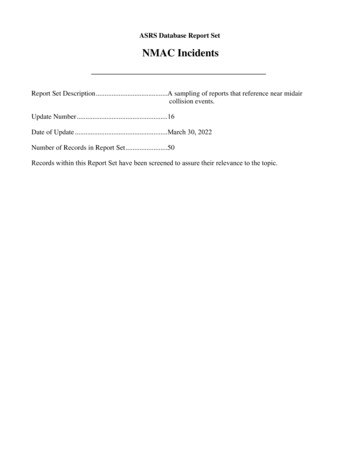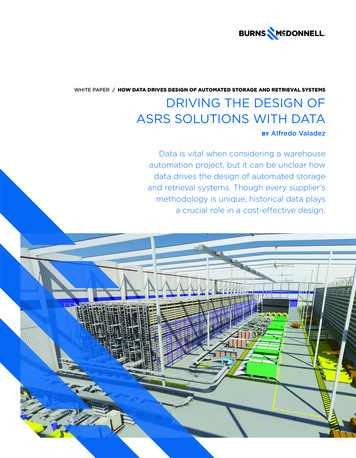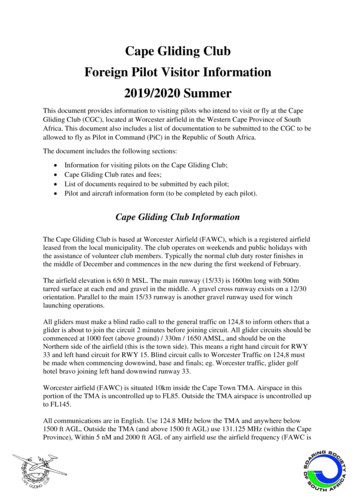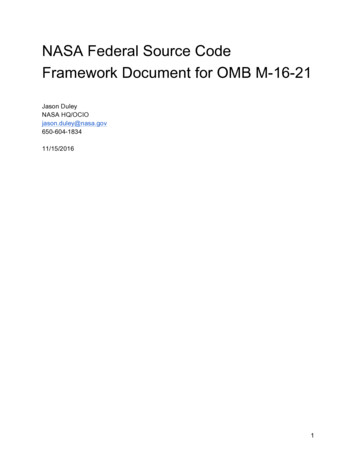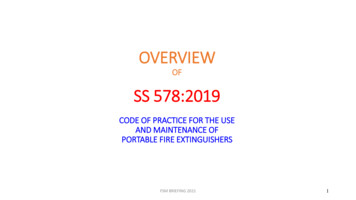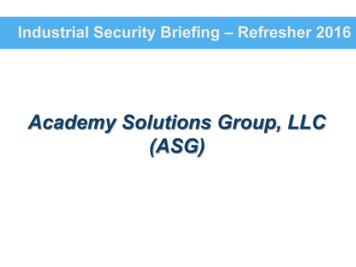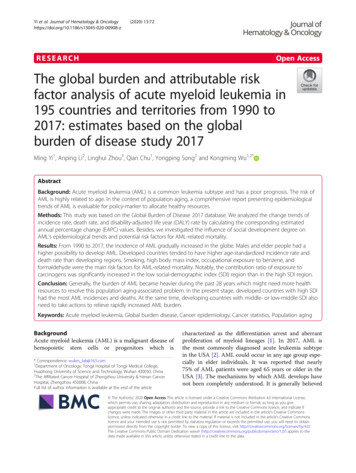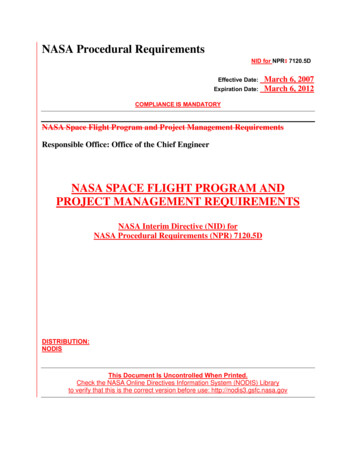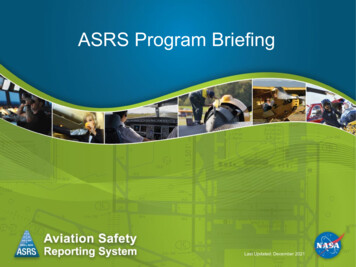
Transcription
ASRS Program BriefingLast Updated: December 2021
ASRS Program Briefing IndexASRS Program OverviewReport ProcessingAlert MessagesQuick ResponsesASRS DatabaseCALLBACKFocused Studies & ResearchASRS Model AppliedASRS SummaryAviation Safety Reporting System311222831384347522
ASRS Program OverviewAviation Safety Reporting System3
ASRS Program OverviewConcept & MissionThe Aviation Safety Reporting System(ASRS) receives, processes andanalyzes voluntarily submitted incidentreports from pilots, air trafficcontrollers, dispatchers, cabin crew,maintenance technicians, UAS crewand others. Reports submitted to ASRSmay describe both unsafe occurrencesand hazardous situations. Informationis gathered from these reports anddisseminated to stakeholders. ASRS'sparticular concern is the quality ofhuman performance in the NationalAirspace System.Aviation Safety Reporting SystemReporting IncentivesVOLUNTARYCONFIDENTIALNON-PUNITIVE4
PurposeASRS Program Overview Identify deficiencies and discrepancies inthe National Airspace System Objective: Improve the current aviation system Provide data for planning and improvementsto the future National Airspace System Objective: Enhance the basis for human factorsresearch and recommendations for future aviationprocedures, operations, facilities, and equipmentAviation Safety Reporting System5
ASRS BackgroundWW II1958ASRS Program OverviewIndustry and Military recognized value of voluntaryincident reportingNeed for U.S. Incident Data System raised during FAAEnactment HearingsOct. 1974United Airlines incident foreshadowed TWA 514 AccidentDec. 1974TWA 514 AccidentApr. 1975Study of the National Air Transportation System as a Result ofthe Secretary’s Task Force on the FAA Safety MissionMay 1975Aviation Safety Reporting Program (ASRP) Implemented (FAA)May 9, 1975Apr. 1976Advisory Circular 00-46A IssuedAviation Safety Reporting System (ASRS) Established(NASA/FAA)Aviation Safety Reporting System6
ASRS StaffASRS Program OverviewThe ASRS Staff is composed of highly experienced pilots, airtraffic controllers and mechanics, as well as a managementteam that possess aviation and human factors experience.ASRS Analysts' experience is comprised of over 600 cumulativeyears of aviation expertise covering the full spectrum of aviationactivity: air carrier, corporate, military, and general aviation; AirTraffic Control in Towers, TRACONs, Centers, and MilitaryFacilities. Analyst cumulative flight time exceeds 175,000 hoursin over 90 different aircraft.In addition, the ASRS Staff has human factors and psychologyresearch experience in areas such as training, fatigue, crewresource management, user interface design, usabilityevaluations, and research methodology.Aviation Safety Reporting System7
Documents Governing ASRSImmunity & ConfidentialityASRS Program Overview Federal Register Notice, 1975 & 1976 Federal Aviation Regulations Part 91.25(14 CFR 91.25) FAA Advisory Circular 00-46F FAA policy concerning Air Traffic Controllersregarding ASRS reporting, FAA Order JO 7200.20AAviation Safety Reporting System8
The Immunity ConceptASRS Program OverviewParagraph 9. c. FAA Advisory Circular No. 00-46Fc. Waiver of Imposition of Sanction. The FAA considers the filing of a report withNASA concerning an incident or occurrence involving a violation of 49 U.S.C.subtitle VII or the 14 CFR to be indicative of a constructive attitude. Such anattitude will tend to prevent future violations. Accordingly, although a finding ofviolation may be made, neither a civil penalty nor certificate suspension will beimposed if:1.The violation was inadvertent and not deliberate;2.The violation did not involve a criminal offense, accident, or action under 49U.S.C. § 44709, which discloses a lack of qualification or competency, which iswholly excluded from this policy;3.The person has not been found in any prior FAA enforcement action to havecommitted a violation of 49 U.S.C. subtitle VII, or any regulation promulgatedthere for a period of 5 years prior to the date of occurrence; and4.The person proves that, within 10 days after the violation, or date when theperson became aware or should have been aware of the violation, he or shecompleted and delivered or mailed a written report of the incident or occurrenceto NASA.Aviation Safety Reporting System9
ASRS StakeholdersAviation Safety Reporting SystemASRS Program Overview10
Report ProcessingAviation Safety Reporting System11
Report Intake OverviewReport ProcessingASRS receives reports from pilots, air traffic controllers,cabin crew, dispatchers, maintenance technicians, groundpersonnel and others involved in aviation operations.ASRS's report intake has been robust from the first days ofthe program, in which it averaged approximately 400reports per month. In recent years, report intake has grownat an enormous rate. However, the COVID-19 Pandemiccaused a decrease in intake. Intake in 2020 averagedabout 1,239 reports per week or 5,471 reports per month.Aviation Safety Reporting System12
Report Intake MetricsReport ProcessingMonthly Report Intake(January 1981 – December 2020) Total ProgramReport Intake 1,781,647 Total Report Intakefor 2020* 65,656 Averaging 5,471reports per month,265 per working day*Reduction in report intake in 2020 is attributed to a reductionin flight operations due to the COVID-19 pandemicAviation Safety Reporting System13
Incident Reporter DistributionReport ProcessingJanuary 2011– December 2020Aviation Safety Reporting System14
Report Processing OverviewReport ProcessingASRS has securely processed over 1.7 million reports inits 44 year history. The process contains critical elementsthat ensure each report is handled in a manner thatmaintains reporter confidentiality while maximizing theability to accurately assess the safety value of eachreport. ASRS report processing begins with the receipt ofreports through electronic submission or from the postoffice, and ends with the final coded report entering theASRS Database.Reports sent to the ASRS are widely regarded as one ofthe world’s largest sources of information on aviationsafety and human factors.Aviation Safety Reporting System15
Report Processing FlowAviation Safety Reporting SystemReport Processing16
Report Processing FlowPaperElectro nicReport ProcessingASRS paper reports are picked-up daily from the Moffett Field PostOffice or are received electronically via website Electronic ReportSubmission (ERS) or ASAP data transmissionsEvery report is date and time stamped based on the date of receiptTwo ASRS Analysts “screen” each report within five working days toprovide initial categorization and to determine the triage of processingASRS Analysts may identify hazardous situations from reports andissue an Alert Message. De-identified information is provided toorganizations in positions of authority for further evaluation andpotential corrective actionsAviation Safety Reporting System17
Report Processing FlowReport ProcessingASRS retains high-level categorization of 100% of reports received.Based on initial categorization, multiple reports on the same event arebrought together to form one database “record”ASRS Analysts identify reports that require further analysis and entryinto the public ASRS database. During the detailed Report Analysisprocess, reports are codified using the ASRS taxonomy.An ASRS Analyst may choose to call a reporter on the telephone toclarify any information the reporter provided. This information is addedto the analysis and final record.To ensure confidentiality all identifying data is removed. After analysis,the Identification (ID) Strip, the top portion of the report, is returned tothe reporter. This ID Strip acts as the reporter’s proof of submittal. Allphysical and electronic ID Strip data with the reporter’s name, address,date and time stamp is removed.Aviation Safety Reporting System18
Report Processing FlowReport ProcessingAll reports that receive further analysis go through a Final Check toassure coding accuracy. Quality Assurance checks are also performedfor coding quality.Final coded reports enter the ASRS Database. These de-identifiedrecords are then available in the ASRS Database Online, which isavailable through the ASRS website.Original reports, both physical and electronic data, are destroyed tocompletely ensure confidentialityASRS uses the information it receives to promote aviation safetythrough a number of products and services, such as Alert Messages,Search Requests, a monthly newsletter, focused studies and moreAviation Safety Reporting System19
ASRS Products & ServicesReport ALLBACKNEWSLETTERFOCUSEDSTUDIESSafety informationissued to organizationsin positions of authorityfor evaluation andpossible correctiveactions.Rapid data analysis byASRS staff on safetyissues with immediateoperational importancegenerally limited togovernment agencies.The public ASRSDatabase Online anddata available inDatabase Report Setsor Search Requests fullfilled by ASRS staff.Monthly newsletter witha lessons learnedformat, available viawebsite and email.Studies/Researchconducted on safetytopics of interest incooperation withaviation organizations.Aviation Safety Reporting System20
Report ProcessingASRS Products & Services MetricsApril 1976 – December 2020Significant ItemsIncident Reports ReceivedQuantity1,799,274Safety Alert Messages6,795Quick Responses144Search Requests7,591CALLBACK Issues491ASRS Directline Issues10Research Studies64Aviation Safety Reporting System21
Alert MessagesAviation Safety Reporting System22
Alert MessagesAlert Message OverviewWhen ASRS receives a report describing a hazardoussituation, for example, a defective navigation aid, anaircraft system anomaly, a confusing procedure, or anyother circumstance which might compromise safe flight –an alerting message is issued using de-identifiedinformation provided in the reports.Alerting messages have a single purpose: to relay safetyinformation to organizations in positions of authority so thatthey can evaluate the information and take possiblecorrective actions.Alert messages are classified as Alert Bulletins or ForYour Information Notices, and may be included inmonthly ASRS Safety Teleconferences.Aviation Safety Reporting System23
Alert MessagesASRS Alerting PyramidASRS has no direct authority to directly correct safety issues.It acts through and with the cooperation of others.Aviation Safety Reporting System24
Alert MessagesAlerting SubjectsJanuary 2011 – December 2020SubjectTotalAircraft Systems413Airports Facility Status and Maintenance310ATC Procedures180Other173Hazards to Flight85Airport Lighting and Approach Aids84ATC Equipment84Navigation73ATC Operations41Aircraft Avionics43Aircraft Power Plants20Aviation Safety Reporting System25
Alert MessagesAlerting ResponsesJanuary 2011 – December 2020ResponsePercentageAction taken as a result of the AB/FYI17.5%Action initiated before AB/FYI received17.3%Action initiated in response to AB/FYI but notcompleted15.6%Addressee agrees with AB/FYI but unable to resolve5.8%Issue raised by AB/FYI under investigation2.4%Addressee disputes factual accuracy of AB/FYI14.1%Information in AB/FYI insufficient for action11.1%Addressee in factual agreement but sees noproblem8.6%Action not within addressee's jurisdiction5.1%For information only, no response expected2.4%Aviation Safety Reporting SystemTotal58.6%26
Alert MessagesExamples of Safety Alerting Success MYL PAPI Out of Service But NOTAM Not Published (FYI 2020-59)A Jeppesen Sanderson Inc., representative responded and stated ".Theprevious Runway 16 PAPI NOTAM expired without us noticing it about 2weeks ago. We recently noted the missing NOTAM and have reentered intothe NOTAM system.” Similar Sounding Fix Names - DRFTR/DRYFT (FYI 2020-124)An FAA (AJV-A) representative responded and stated, "We’ll coordinate withATC and replace one of the fix names." Jeppesen FD Pro User Confusion (FYI 2020-4)A Jeppesen Sanderson Inc., representative responded and stated "This wasanother interesting one. I did work with our Standards Department andSoftware Experts. They thought this was a bug in that previous highlightingshould disappear when a revised chart displays, as the Reporter indicates.They told me they would look into it, but were not able to provide me timeline."Aviation Safety Reporting System27
Quick ResponsesAviation Safety Reporting System28
Quick Response OverviewQuick ResponsesQuick Responses are rapid turnaround data analysisthat are typically accomplished within two to tenbusiness days of the request. They are a high valueservice directed towards safety issues with immediateoperational importance. Quick Responses aregenerally limited to government agencies such asFAA, DOT, NTSB, NASA, and U.S. Congress.Aviation Safety Reporting System29
Quick Response ApplicationsQuick Responses An Analysis of Unmanned Aerial Vehicle (UAV) RelatedIncidents An Analysis of NOTAM Related Incidents An Analysis of Flight Service Station Related Incidents An Analysis of General Aviation ADS-B RelatedIncidents An Analysis of Part 121 Similar Call Sign RelatedIncidentsAviation Safety Reporting System30
ASRS DatabaseAviation Safety Reporting System31
Search RequestsASRS DatabaseInformation in the ASRS Database is available publicly.The ASRS will provide Search Requests to members ofthe aviation community. ASRS will search its database,download relevant reports, and send to requestor.Since the inception of ASRS, over 7,591 Search Requests(SRs) have been directly provided by ASRS ResearchStaff to various aviation organizations and agencies, aswell as individuals through December 2020.Aviation Safety Reporting System32
ASRS DatabaseSearch Requestors by OrganizationJanuary 2011 – December aneous Government7Air Carriers67Other6NTSB56Aircraft Manufacturers5NASA54Military4Media31Research Organizations4Alphabet Groups22Student3Miscellaneous Safety Organizations13DHS1Foreign8Educational Institutes1Individuals8Aviation Safety Reporting System33
ASRS DatabaseRecent Search Request Samples B737 MAX 8 Related Incidents (SR 7299) Completed for the FAA (AVP), Accident Prevention Office Contract Maintenance Related Incidents (SR 7300) Completed for the FAA (AVP), Accident Prevention Office EMB-135/140/145 Runway Excursion Related Incidents(SR 7307) Completed for the NTSB NYC Metroplex Reports (SR 7309) Completed for the FAA (ANG-C1), NextGen Human FactorsDivision OfficeAviation Safety Reporting System34
ASRS DatabaseASRS Database OnlineDirect access to search de-identified reports in the ASRSdatabase is available through ASRS Database Online(DBOL) at https://asrs.arc.nasa.gov/search/database.html. Over 1,700 queriesare completed eachmonth More than 287,528DBOL queriescompleted since itslaunch in July 2006Aviation Safety Reporting System35
ASRS Database Report SetsASRS DatabaseFor your convenience, selected relevant reports on severalsafety topics are available on the website called ASRSDatabase Report Sets. Each report set consists of 50ASRS Database records, all pre-screened to assure theirrelevance to the pre-selected topic and are available .From the ASRS website, ASRS Database Report Sets aredownloaded on average over 2,235 times a month. ReportSets were first posted in January 2000.Aviation Safety Reporting System36
ASRS Database Report SetsASRS Database2020 Top Ten Report SetsReport Set TopicTotal DownloadsUnmanned Aerial Vehicle (UAV) Reports2,570Passenger Electronic Devices2,566Passenger Misconduct Reports1,658Flight Attendant Reports1,648Cabin Smoke, Fire, Fumes, or Odor Incidents1,546Altitude Deviations1,258Penetration of Prohibited Airspace1,168Air Carrier (FAR 121) Flight Crew Fatigue Reports1,098CRM Issues1,074Maintenance Reports1,049Aviation Safety Reporting System37
CALLBACKAviation Safety Reporting System38
CALLBACKCALLBACK OverviewCALLBACK, the award winning ASRS monthly safetynewsletter, has been published since 1979 in a popular“lessons learned” format. CALLBACK presents ASRS reportexcerpts that are significant, educational, and timely.Occasionally features on ASRS program developments andresearch are also presented. Over 491 issues have beenpublished and distributed throughout the U.S. and to theinternational aviation community. All issues since December1994 are available for download at the ASRS website .htmlAviation Safety Reporting System39
CALLBACKCALLBACK Distribution and Subscription In addition to being published online, CALLBACK isdistributed by email. Subscription is free and available viathe ASRS website. The total number of emailsubscribers for 2020was over 32,200 CALLBACK views for2020 (HTML and PDF)were over 194,500Aviation Safety Reporting System40
CALLBACKCALLBACK Topics2020 CALLBACK Topics Covered Airmanship and AutomationCOVID-19Ground OperationsInteractive Situational ResolutionsLate Clearance ChangesMaintainer Related IncidentsMEL MisstepsPilot ProficiencyRNAV (RNP) ApproachesVFR Flight Into IMCWinter WeatherAviation Safety Reporting SystemIssue 482, MarchIssue 488, SeptemberIssue 490, November41
CALLBACKAviation Community FeedbackSample Reader Comments from 2020“ASRS Callback is my favorite aviation publication. The reports are always relevant and the summaries and headlines are extremely well written, creative, and oftenentertaining. An excellent example is "If the Nozzle Fits" in the December 2019Callback. This should be required reading for ALL pilots because it describes thesame situation which very recently resulted in a fatal accident It's not alwayspractical or convenient to supervise the fueling of the airplane - but the consequencesof mis-fueling certainly warrant it. Thanks again for a great publication.”“Issue 477 has an article titled Quietly Left Holding the Bag. The event took place inmy sector. The Local Safety Council (LSC) agreed with the co-pilot's interpretation ofthe instructions. We will bring this to that area's attention to be sure this is not a morewidespread issue.”“I've been reading Callback for over 20 years and have submitted a few reports overthat time. ASRS, Callback and your safety efforts over the years have probably savedlives but we rarely know that.”Aviation Safety Reporting System42
FocusedStudies/ResearchAviation Safety Reporting System43
Focused Studies / ResearchFocused on Operations and Human Factors 64 Research Studies and Special Papers Published Operations: Deviations, De-Icing/Anti-Icing, Rejected Takeoffs,Clearances, Weather Encounters, Landing Incidents, RunwayTransgressions, TCAS II, Crossing Restrictions, etc. Human Factors: Communication, Memory, Confusion, TimePressure, Judgment, Training, Crew Performance, Flight CrewMonitoring, etc. Confidential Reporting: ASRS Reporting Model, Case forConfidential Reporting, Development of ASRS, Cross IndustryApplications, etc. Research agendas are developed in collaboration withgovernment and industry safety organizations There are over 30 ASRS Research Papers available todownload on the ASRS websiteAviation Safety Reporting System44
Focused Studies / ResearchFocused Study – Wake VortexWake Vortex Encounter StudyIn cooperation with the FAA, ASRS is currentlyexamining Wake Vortex Encounter incidents reportedto ASRS. ASRS began this study in 2007 and willcontinue through 2021. At present the Wake VortexEncounter Study includes all airspace within theUnited States, enroute and terminal. In quarterlyreports, the ASRS documents event dynamics and contributingfactors underlying unique wake vortex encounter incidents.A sampling of the factors to be analyzed includes reporters’assessed magnitude of wake encounter, aircraft spacing, aircrafttype, runway configuration, and consequences from the encounter.Aviation Safety Reporting System45
Focused Studies / ResearchFocused Study – AIS Data LinkMeteorological and Aeronautical InformationServices Data Link Services and Applications StudyIn cooperation with the FAA, ASRS conducted a studyfocused on meteorological and aeronauticalinformation services (AIS) via data link. ASRSgathered reports of incidents that occurred whilepilots were utilizing weather or AIS information in thecockpit (textual and/or graphical) obtained via datalink (including ACARS) or other sources on theground or in the air.Some factors analyzed included type of weather data received,cockpit display utilized, software or applications used to receivemeteorological information, and end user graphical interface issues.Aviation Safety Reporting System46
ASRS Model AppliedAviation Safety Reporting System47
ASRS Model AppliedASRS Model AppliedThe ASRS model is utilized internationally in the aviationcommunity. The International Confidential Aviation SafetySystems (ICASS) Group promotes confidential reporting systemsas an effective method of enhancing flight safety in commercialair transport and general aviation operations.International Civil Aviation Organization (ICAO) has revisedAnnex 13 – Accident Prevention and created Annex 19, Chapter5, which addresses member states establishing a voluntaryincident reporting system.Aviation Safety Reporting System48
ASRS Model Applied toInternational Aviation CommunityASRS Model Applied UNITED STATES: Aviation Safety Reporting System (ASRS) [1976] UNITED KINGDOM: Confidential Human Incident Reporting Program (CHIRP) [1982] CANADA: Confidential Aviation Safety Reporting Program (CASRP) [1985], SECURITAS [1995] AUSTRALIA: CAIR [1988], Report Confidentially (REPCON) [2007] BRAZIL: Confidential Flight Safety Report (RCSV) [1997] JAPAN: Aviation Safety Information Network (ASI-NET) [1999], VOICES Reporting System [2014] FRANCE: Confidential Events Reporting System (REC) [2000], REX [2011] TAIWAN: Taiwan Confidential Aviation Safety Reporting System (TACARE) [2000] SOUTH KOREA: Korea Aviation hindrance Reporting System (KAIRS) [2000] CHINA: Sino Confidential Aviation Safety System (SCASS) [2004] SINGAPORE: Singapore Confidential Aviation Incident Reporting (SINCAIR) [2004] SPAIN: Safety Occurrence Reporting System (SNS) [2007]Safety Reporting System – SEPLA (SRS) [2007] SOUTH AFRICA: Civil Aviation Hazard Reporting System (CAHRS) [2013]Aviation Safety Reporting System49
ASRS Model Applied toInternational Aviation CommunityUnited KingdomCHIRP (1982)United StatesASRS (1976)CanadaCASRP (1985)SECURITAS (1995)SpainSNS/SRS (2007)RussiaVASRPJapanASI-NET (1999)VOICES (2014)GermanyEUCAREFranceREC (2000)REX (2011)ASRS Model AppliedChinaSCASS (2004)TaiwanTACARE (2000)South KoreaKAIRS (2000)SingaporeSINCAIR (2004)BrazilRCSV (1997)South AfricaCAHRS (2013)AustraliaCAIR (1988)REPCON (2007)New ZealandICARUSInternational Confidential Aviation Safety Systems (ICASS)50
ASRS Model ApplicationsASRS Model AppliedBecause of the success of ASRS, the ASRS reporting model isalso being applied to other disciplines such as railroad, medicine,security, firefighting, maritime, law enforcement, and others.RAILSECURITYMEDICINEPUBLIC UTILITIESAviation Safety Reporting SystemMARITIMEFIREFIGHTINGSTRUCTURALENGINEERING51
ASRS SummaryAviation Safety Reporting System52
ASRS SummaryASRS SummaryASRS is a highly successful and trusted program that hasserved the needs of the aviation community for over 44 years. Itis available to all participants in the National Airspace Systemwho wish to report safety incidents and situations.The ASRS identifies system deficiencies, and issues alertingmessages to persons in a position to correct them. It educatesthrough its newsletter CALLBACK, participation in governmentand industry meetings, and through its research studies. Itsdatabase is a public repository which serves the needs of theFAA and NASA, and those of other organizations world-widewhich are engaged in research and the promotion of safe flight.Aviation Safety Reporting System53
Advantages of the ASRS ModelASRS Summary System-Wide Perspective System-Wide Alerting Data Processing through Expert Analysts Comprehensive and Time Tested Coding Taxonomy Strong Immunity and Legal Provisions Information Sharing on Aviation Safety National and International ReputationAviation Safety Reporting System54
Why Confidential Reporting WorksASRS Summary When organizations want to learn more about the occurrenceof events, the best approach is simply to ask those involved People are generally willing to share their knowledge if theyare assured Their identities will remain protected There is no disciplinary or legal consequences A properly constructed confidential, voluntary, non-punitivereporting system can be used by any person to safely shareinformation Confidential reporting systems have the means to answer thequestion why - why a system failed, why a human erred Incident/event data are complementary to the data gatheredby other monitoring systemsAviation Safety Reporting System55
Thank You Contact the NASA ASRS Director Becky L. Hooey– Becky.L.Hooey@nasa.gov Additional Information & Resources Confidentiality & Incentives to iality.html Immunity y.html Requesting ASRS mlAviation Safety Reporting System56
maintains reporter confidentiality while maximizing the ability to accurately assess the safety value of each report. ASRS report processing begins with the receipt of reports through electronic submission or from the post office, and ends with the final coded report entering the ASRS Database. Reports sent to the ASRS are widely regarded as one of the world's largest sources of information .

